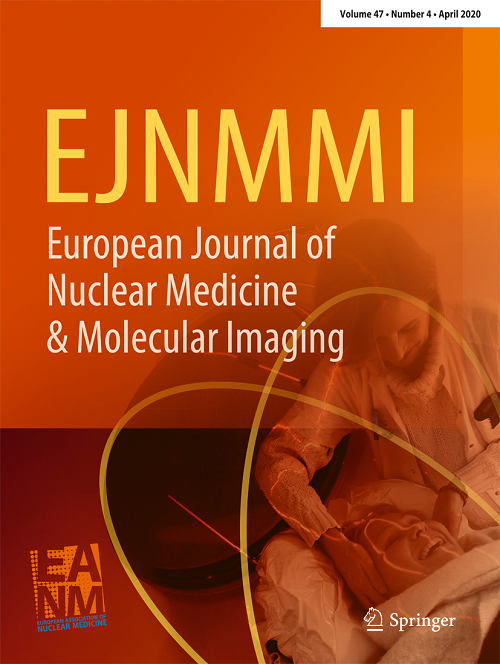Efficacy and safety of [18F]NaF PET/CT guided intraarticular block for lumbar facet joint and sacroiliac joint arthropathy: a single-arm phase 2 trial.
IF 7.6
1区 医学
Q1 RADIOLOGY, NUCLEAR MEDICINE & MEDICAL IMAGING
European Journal of Nuclear Medicine and Molecular Imaging
Pub Date : 2025-08-15
DOI:10.1007/s00259-025-07516-4
引用次数: 0
Abstract
PURPOSE To evaluate the efficacy and safety of robotic-arm-assisted [18F]NaF-PET/CT-guided intra-articular block for lumbar facet joint (LFJ) or sacroiliac joint (SIJ) arthropathy. MATERIALS AND METHODS In this single-centre, non-randomized, prospective phase 2 clinical-trial, participants with chronic low back pain (CLBP) were recruited from August 2022 to June 2024. Participants having NaF-avid LFJ or SIJ on [18F]NaF-PET/CT underwent robotic-arm-assisted intra-articular block with steroids and local anaesthesia. Baseline, immediate post-procedural, and 3-month follow-up visual analog score (VAS), Low-Back Outcome Scale (LBOS), Oswestry Disability Index (ODI), and change in SUV values of target joints were documented. The primary end-point of the trial was ≥ 50% improvement in VAS at 3 months, and secondary end-points were improvements in ODI, LBOS by at least one grade and change in SUV. Descriptive statistics were applied. Qualitative variables were reported in percentages. RESULTS Out of 85 enrolled participants, 79 (92.9%) underwent [18F]NaF-PET/CT. Among them, 61 (77.2%) had NaF-avid joints, and 55(69.6%) underwent PET/CT-guided robotic-arm-assisted intra-articular blocks. The primary end-point was met in 84% (46/55) participants, and secondary end-points in 96% (53/55) and 89% (49/55), respectively. The procedure was technically successful in all the target joints. A significant change in pre- and post-procedural median SUVmax and SUVpeak of the treated joints was noticed. No major adverse effects were noticed in the participants. CONCLUSION Robotic-arm-assisted [18F]NaF-PET/CT guided intra-articular blocks of LFJ and SIJ in CLBP appear to be safe and feasible in NaF-avid arthropathy. However, lack of comparison with the standard of care, small sample size, selection bias and radiation exposure limit its generalizability.[18F]NaF PET/CT引导下关节内阻滞治疗腰椎小关节和骶髂关节病变的疗效和安全性:单臂2期试验
目的评价机械臂辅助[18F]NaF-PET/ ct引导下关节内阻滞治疗腰椎小关节(LFJ)或骶髂关节(SIJ)关节病的疗效和安全性。材料和方法在这项单中心、非随机、前瞻性2期临床试验中,从2022年8月至2024年6月招募了患有慢性腰痛(CLBP)的参与者。在[18F] naff - pet /CT上有naff -avid LFJ或SIJ的参与者接受机械臂辅助的关节内类固醇阻滞和局部麻醉。记录基线、术后即时和3个月随访的视觉模拟评分(VAS)、腰背结局量表(LBOS)、Oswestry残疾指数(ODI)和目标关节SUV值的变化。试验的主要终点为3个月时VAS改善≥50%,次要终点为ODI、LBOS改善至少1级和SUV变化。采用描述性统计。定性变量以百分比报告。结果85名入组参与者中,79名(92.9%)接受了[18F] nafpet /CT检查。其中61例(77.2%)关节有nafi, 55例(69.6%)接受了PET/ ct引导的机械臂辅助关节内阻滞。主要终点达到84%(46/55),次要终点分别达到96%(53/55)和89%(49/55)。手术在所有的目标关节上都是成功的。观察到手术前后治疗关节的中位SUVmax和SUVpeak有显著变化。在参与者中没有发现主要的不良反应。结论机械臂辅助[18F]NaF-PET/CT引导下CLBP患者LFJ和SIJ关节内阻滞治疗NaF-avid关节病是安全可行的。然而,缺乏与护理标准的比较,样本量小,选择偏差和辐射暴露限制了其普遍性。
本文章由计算机程序翻译,如有差异,请以英文原文为准。
求助全文
约1分钟内获得全文
求助全文
来源期刊
CiteScore
15.60
自引率
9.90%
发文量
392
审稿时长
3 months
期刊介绍:
The European Journal of Nuclear Medicine and Molecular Imaging serves as a platform for the exchange of clinical and scientific information within nuclear medicine and related professions. It welcomes international submissions from professionals involved in the functional, metabolic, and molecular investigation of diseases. The journal's coverage spans physics, dosimetry, radiation biology, radiochemistry, and pharmacy, providing high-quality peer review by experts in the field. Known for highly cited and downloaded articles, it ensures global visibility for research work and is part of the EJNMMI journal family.

 求助内容:
求助内容: 应助结果提醒方式:
应助结果提醒方式:


